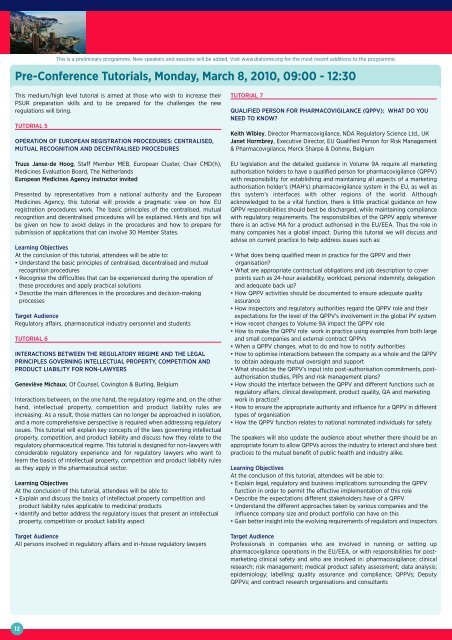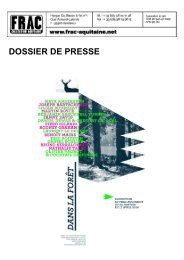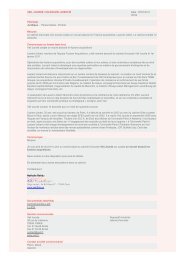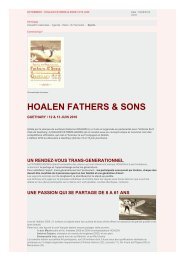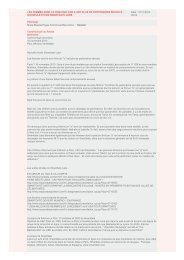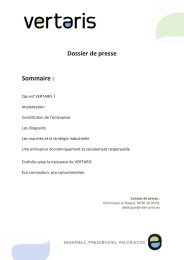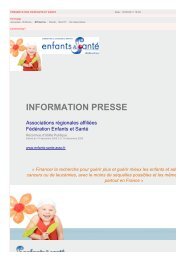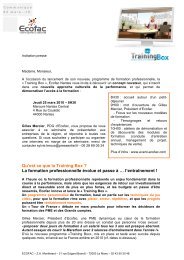Pre-Conference Tutorials, Monday, March 8, 2010, 09:00
Pre-Conference Tutorials, Monday, March 8, 2010, 09:00
Pre-Conference Tutorials, Monday, March 8, 2010, 09:00
You also want an ePaper? Increase the reach of your titles
YUMPU automatically turns print PDFs into web optimized ePapers that Google loves.
12<br />
This is a preliminary programme. New speakers and sessions will be added. Visit www.diahome.org for the most recent additions to the programme.<br />
<strong>Pre</strong>-<strong>Conference</strong> <strong>Tutorials</strong>, <strong>Monday</strong>, <strong>March</strong> 8, <strong>2010</strong>, <strong>09</strong>:<strong>00</strong> - 12:30<br />
This medium/high level tutorial is aimed at those who wish to increase their<br />
PSUR preparation skills and to be prepared for the challenges the new<br />
regulations will bring.<br />
TUTORIAL 5<br />
OPERATION OF EUROPEAN REGISTRATION PROCEDURES: CENTRALISED,<br />
MUTUAL RECOGNITION AND DECENTRALISED PROCEDURES<br />
Truus Janse-de Hoog, Staff Member MEB, European Cluster, Chair CMD(h),<br />
Medicines Evaluation Board, The Netherlands<br />
European Medicines Agency instructor invited<br />
<strong>Pre</strong>sented by representatives from a national authority and the European<br />
Medicines Agency, this tutorial will provide a pragmatic view on how EU<br />
registration procedures work. The basic principles of the centralised, mutual<br />
recognition and decentralised procedures will be explained. Hints and tips will<br />
be given on how to avoid delays in the procedures and how to prepare for<br />
submission of applications that can involve 30 Member States.<br />
Learning Objectives<br />
At the conclusion of this tutorial, attendees will be able to:<br />
• Understand the basic principles of centralised, decentralised and mutual<br />
recognition procedures<br />
• Recognise the difficulties that can be experienced during the operation of<br />
these procedures and apply practical solutions<br />
• Describe the main differences in the procedures and decision-making<br />
processes<br />
Target Audience<br />
Regulatory affairs, pharmaceutical industry personnel and students<br />
TUTORIAL 6<br />
INTERACTIONS BETWEEN THE REGULATORY REGIME AND THE LEGAL<br />
PRINCIPLES GOVERNING INTELLECTUAL PROPERTY, COMPETITION AND<br />
PRODUCT LIABILITY FOR NON-LAWYERS<br />
Geneviève Michaux, Of Counsel, Covington & Burling, Belgium<br />
Interactions between, on the one hand, the regulatory regime and, on the other<br />
hand, intellectual property, competition and product liability rules are<br />
increasing. As a result, those matters can no longer be approached in isolation,<br />
and a more comprehensive perspective is required when addressing regulatory<br />
issues. This tutorial will explain key concepts of the laws governing intellectual<br />
property, competition, and product liability and discuss how they relate to the<br />
regulatory pharmaceutical regime. This tutorial is designed for non-lawyers with<br />
considerable regulatory experience and for regulatory lawyers who want to<br />
learn the basics of intellectual property, competition and product liability rules<br />
as they apply in the pharmaceutical sector.<br />
Learning Objectives<br />
At the conclusion of this tutorial, attendees will be able to:<br />
• Explain and discuss the basics of intellectual property competition and<br />
product liability rules applicable to medicinal products<br />
• Identify and better address the regulatory issues that present an intellectual<br />
property, competition or product liability aspect<br />
Target Audience<br />
All persons involved in regulatory affairs and in-house regulatory lawyers<br />
TUTORIAL 7<br />
QUALIFIED PERSON FOR PHARMACOVIGILANCE (QPPV): WHAT DO YOU<br />
NEED TO KNOW?<br />
Keith Wibley, Director Pharmacovigilance, NDA Regulatory Science Ltd., UK<br />
Janet Hormbrey, Executive Director, EU Qualified Person for Risk Management<br />
& Pharmacovigilance, Merck Sharpe & Dohme, Belgium<br />
EU legislation and the detailed guidance in Volume 9A require all marketing<br />
authorisation holders to have a qualified person for pharmacovigilance (QPPV)<br />
with responsibility for establishing and maintaining all aspects of a marketing<br />
authorisation holder’s (MAH’s) pharmacovigilance system in the EU, as well as<br />
this system’s interfaces with other regions of the world. Although<br />
acknowledged to be a vital function, there is little practical guidance on how<br />
QPPV responsibilities should best be discharged, while maintaining compliance<br />
with regulatory requirements. The responsibilities of the QPPV apply wherever<br />
there is an active MA for a product authorised in the EU/EEA. Thus the role in<br />
many companies has a global impact. During this tutorial we will discuss and<br />
advise on current practice to help address issues such as:<br />
• What does being qualified mean in practice for the QPPV and their<br />
organisation?<br />
• What are appropriate contractual obligations and job description to cover<br />
points such as 24-hour availability, workload, personal indemnity, delegation<br />
and adequate back up?<br />
• How QPPV activities should be documented to ensure adequate quality<br />
assurance<br />
• How inspectors and regulatory authorities regard the QPPV role and their<br />
expectations for the level of the QPPV’s involvement in the global PV system<br />
• How recent changes to Volume 9A impact the QPPV role<br />
• How to make the QPPV role work in practice using examples from both large<br />
and small companies and external contract QPPVs<br />
• When a QPPV changes, what to do and how to notify authorities<br />
• How to optimise interactions between the company as a whole and the QPPV<br />
to obtain adequate mutual oversight and support<br />
• What should be the QPPV’s input into post-authorisation commitments, postauthorisation<br />
studies, PIPs and risk management plans?<br />
• How should the interface between the QPPV and different functions such as<br />
regulatory affairs, clinical development, product quality, QA and marketing<br />
work in practice?<br />
• How to ensure the appropriate authority and influence for a QPPV in different<br />
types of organisation<br />
• How the QPPV function relates to national nominated individuals for safety<br />
The speakers will also update the audience about whether there should be an<br />
appropriate forum to allow QPPVs across the industry to interact and share best<br />
practices to the mutual benefit of public health and industry alike.<br />
Learning Objectives<br />
At the conclusion of this tutorial, attendees will be able to:<br />
• Explain legal, regulatory and business implications surrounding the QPPV<br />
function in order to permit the effective implementation of this role<br />
• Describe the expectations different stakeholders have of a QPPV<br />
• Understand the different approaches taken by various companies and the<br />
influence company size and product portfolio can have on this<br />
• Gain better insight into the evolving requirements of regulators and inspectors<br />
Target Audience<br />
Professionals in companies who are involved in running or setting up<br />
pharmacovigilance operations in the EU/EEA, or with responsibilities for postmarketing<br />
clinical safety and who are involved in: pharmacovigilance; clinical<br />
research; risk management; medical product safety assessment; data analysis;<br />
epidemiology; labelling; quality assurance and compliance; QPPVs; Deputy<br />
QPPVs; and contract research organisations and consultants


